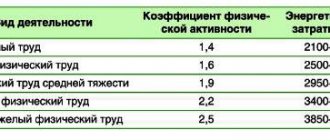Features of training
How much should you run to lose weight? This question interests a person who wants to fight unnecessary pounds with the help of running training. Sports experts believe that active fat burning starts in 30-40 minutes. after a low-intensity run. Until this time, the body is saturated with energy by burning carbohydrates, namely glycogen, contained in large quantities in muscle mass and liver. It turns out that to obtain the desired result, the training duration is at least 50-60 minutes. Energy expenditure is determined by running speed, the activity of the runner and the duration of the race. A novice athlete will lose 500-600 kcal per hour during an hour-long run. In the future, his movements will become practiced and technically correct, the speed will increase and energy consumption will be about 800 kcal per hour. It is worth considering that running over rough terrain increases the load, and, therefore, more calories will be consumed per hour.
Why running is good for weight loss
So, does running help you lose weight? Let's figure it out.
Problems with excess weight are usually typical for people leading a sedentary lifestyle. Moreover, now a good half of the population has personal vehicles. Thanks to cars, we stop not only running, but actually walking. As a result, the body accumulates fat, and the muscles atrophy due to uselessness.
To avoid obesity and unpleasant consequences for your appearance and health, you need to pull yourself together and go for a run. This is the simplest type of physical activity that is available to everyone. And let it be just a brisk walk at first. As soon as your body adapts, start running.
Let's take a closer look at how running burns fat?
Running makes your heart pump faster, which is why it is classified as cardio. With an accelerated heart rate, more blood passes through the heart per unit of time than in a calm state. The lungs also begin to work harder, and your blood is actively enriched with oxygen. Oxygen saturation occurs in all cells of the body, from the tips of the toes to the brain. Metabolic processes begin to proceed faster.
Running requires energy. To ensure its constant influx, the body uses up its internal reserves. First, the glycogen stored in the liver is consumed, then the fatty deposits of our body are used. Therefore, running and excess weight are incompatible concepts. If you move actively and burn more calories than you consume from food, your excess weight will disappear. Running and losing weight are interconnected things.
- For jogging (7-9 kilometers per hour), fat burning begins after 20-30 minutes of continuous running.
- With interval training, the process of fat breakdown begins much earlier; you do not need to run for an hour to start fat catabolism. But interval running is quite a heavy load and this type of cardio is not suitable for everyone.
When talking about whether running helps you lose weight, it is important to clarify its type and duration. If we mean classic jogging at an easy pace, the duration of the workout should be at least thirty minutes.
Duration of classes
How much should you run a day to lose weight? Beginners are advised to start racing with 10-15 minutes. For those who do morning exercises every day and are constantly on the move, the first training can last 15-20 minutes. They are carried out first 2-3 times. per week, and then do it daily. The load is gradually increased to 5 minutes and adjusted to 1 hour. This time period is the optimal cardio load for those who decide to lose weight. Longer races lead to fatigue, increased heart activity and excessive pumping of the leg muscles. This does not apply to marathon runners, because their goal is to cover a long distance, and not to lose weight.
The benefits of running for weight loss and more
Running to burn fat is a simple and effective way to get rid of excess weight. It’s not for nothing that this sport has gained immense popularity all over the world. It has a number of advantages , including the following:
- Running is accessible, it does not require financial investment or special equipment, so anyone can do it.
- This is a safe sport, and if you follow the basic rules, it will only bring benefits.
- Regular exercise really helps you lose weight, as it provides a powerful cardio workout. On average, an hour of running burns 500-700 kcal.
- Running gives a person comprehensive benefits, and this concerns not only the figure, but also health. It helps fight stress, strengthens the nervous system, trains the heart and blood vessels, improving their functioning.
- Jogging normalizes the functioning of the digestive system and speeds up metabolism.
- Running perfectly strengthens muscles and keeps them toned.
- This type of activity stimulates the removal of harmful waste, toxins, and excess fluid from the body.
Despite the fact that running will help everyone lose weight, you need to take into account its contraindications , and they are as follows:
- serious disturbances in the functioning of the heart and blood vessels (heart defects, heart failure, blood pressure problems);
- phlebeurysm;
- bronchial asthma;
- endocrine system disorders;
- serious vision problems;
- inflammatory processes in the body;
- infectious diseases;
- problems of the musculoskeletal system.
Very overweight people should consult a specialist before starting jogging, as they may cause harm to themselves. In their case, brisk walking or jogging may be more appropriate.
To lose weight through running, it is recommended to study different options and choose the best one. It is also very important to know how to run correctly to burn fat, to study all the rules and recommendations.
Running intensity
How much should you run to lose weight without harming your body? To do this, you need to monitor cardiac activity and measure the pulse. A specific scheme has been developed for burning fat while jogging. The indicator is determined by the age of the training person. Young and middle-aged athletes in good health have a resting heart rate of 60-80 beats/min. During physical activity, the pulse should not exceed 115-135 beats/min. The maximum pulsation during intense training is 150 beats/min. Higher readings are considered a dangerous signal and carry health risks.
If your heart rate increases sharply, you should start walking, but do not stop. Continue moving at a brisk pace or reduce the speed of the race. It still burns calories. The main condition is not to reduce the time of running loads. With a training session that lasts 45-60 minutes. unnecessary kilograms are still falling off.
Where can you lose fat by running?
Will running help you lose weight in your legs? Since running uses your legs, running is effective for losing weight in your legs first. More precisely, let's put it this way - fat disappears throughout the body, but by training the muscles, your legs will look slimmer and more toned. Proper running for weight loss will also help remove fat from the buttocks, waist, hips and all other problem areas.
There is no such thing as spot removal of fat. Don't expect the fat to magically disappear from just your belly. Indeed, running will, of course, help to remove your belly, but the extra centimeters will go away not only from the waist area, the upper part of the body will also lose weight.
So you don’t have to worry about how to run correctly in order to lose weight in your legs or in some other place - the fat will leave the problem area in parallel with the rest of the body.
When do results appear?
How much should you run to lose weight and get noticeable results? At the initial stages of training, adhering to a uniform increase in physical activity, you will lose 0.5-1 kg of body weight per week. In the future, the body will begin to lose 1.5 kg. in Week. It should be remembered that sudden weight loss has a negative impact on health, and quickly lost kilograms also quickly return. For weight loss, the optimal indicators are to lose 5-6 kg per month. Once a certain level is reached, body weight will stop losing. This means that an optimal body shape has been acquired, and they continue to train to maintain it.
Running for weight loss: how to run to lose weight?
If you choose running as an aid to losing weight, you need to clearly set your priorities while on the beach, otherwise there is a risk of going to extremes. Bulimia, anorexia and other eating disorders are very common among track and field athletes and triathletes. If you're starting to run to lose a few extra pounds, don't combine that goal with an underlying desire to break a world record at one of the distances. By losing weight, we create a deficit of calories and reserves, and, of course, this can affect athletic performance. Hence rule No. 1: clearly define the goal. Weight loss or athletic performance?
Rule No. 2: the best is slow, but reliable and safe results. Running cannot be a panacea. In order to lose weight, it is important to put your diet in order and create a slight calorie deficit. And then, without increasing your caloric intake, gradually introduce or increase the load. That is, do training more intensely or longer. Without extreme restrictions, weight loss will be slower, but this is our goal, because slow weight loss has a better effect on the result and is less stressful for the body. Rule #3: safety comes first! Introduce running gradually, remember about technique and equipment. If before the moment a person set out to lose weight, he did not engage in any sport, we can say with confidence that any physical activity will contribute to weight loss. In this regard, running will most likely become the most convenient way, because we can run anywhere - at the very initial stage, it is enough to take care of good equipment and understand the basic principles of running technique, the observance of which will help the novice runner not to get injured. If a new runner has a fairly heavy build, the risk of knee injuries may increase - and this is something to pay special attention to. Helpers here will be properly selected running shoes with a high level of shock absorption and, of course, technique, technique and technique again! If your excess weight is no more than 10 kilograms, then running is perfect. If excess weight significantly exceeds this figure, then at the initial stage of working on your figure it is better to refrain from running so as not to risk the health of the joints, which will bear a colossal load.
Rule No. 4: the ideal fat-burning running workout is a long, low-intensity cross-country run. And, of course, classes should be regular! So, you have assessed all the risks, selected your equipment and decided to go for your first run. What other rules need to be followed for running to help you lose weight? For about the first 40 minutes of a run, the body runs on glycogen, a complex carbohydrate that is stored in the liver and muscles. It takes more than 40 minutes for the body to start burning fat. This is quite an impressive period of time for a beginner runner, so at first you can alternate between running and fast walking. The ideal running workout for weight loss is a long, monotonous run at a constant speed and heart rate not exceeding 145-150 beats per minute (blue zone). Over time, such cross-countries can begin to be alternated with other types of training. Which ones? A competent running specialist or coach, for example, at MySportExpert, can advise you. Rule No. 5: to lose weight, don’t forget to eat! “To lose weight, you need to not eat” is a terrible myth. Be sure to eat after training, the body must restore strength! A diet is not starvation, but the right set of foods and a balanced diet. And of course, drink enough fluids to maintain a high metabolic rate and recovery. This norm is different for everyone, but on average, doctors recommend drinking from 1.5 to 2 liters of water per day.
You can get advice on nutrition, running technique or choose running equipment at MySportExpert. You can sign up on the website or by phone
Useful tips
For greater effectiveness, trainers advise jogging to lose weight, while adhering to the following rules:
- run regularly and at a suitable rhythm;
- train at the same time (morning, evening or afternoon);
- 1.5 hours before the race and the same amount of time after it is necessary to refrain from consuming any food, this will have a greater effect on burning calories;
- It is permissible to drink still water during exercise;
- follow the principles of healthy eating (eat in small portions 5-6 rubles per day);
- do not eat before bedtime;
- the diet is varied with fermented milk products, fish, poultry and an assortment of fruits and vegetables. The consumption of sweet and flour products is kept to a minimum. Beans and grains (except rice) are prepared for side dishes;
- maintain a drinking regime (1.5-2 liters per day);
- monitor your breathing. It is advisable to breathe through your nose and mouth at the same time to capture more air;
- consult a therapist first and make sure there are no contraindications;
- pay attention to the equipment. Clothing is chosen to allow it to breathe. Shoes chosen are sports, specifically designed for jogging.
Burning fat while running
Ideally, the fat burning process takes place, as a rule, at a running pace that is comfortable for a person. According to experts, if a person can theoretically maintain the chosen pace for eight hours without strain, then it is optimal.
In addition, the body benefits from running not only during the workout, but also after it, since it continues to burn fat for another two to three hours after the end of the run. To lose weight, it is also recommended not to eat during this period; it is better to limit your fluid intake and, perhaps, a small amount of protein.
Jogging on an empty stomach
If your form and health allow you to jog at a slow pace before breakfast, which speeds up your metabolism and promotes fat burning, you must follow the rules:
- You should run in the morning on an empty stomach. The maximum duration of a run is 40 minutes.
- The maximum oxygen consumption is approximately 50-60%. To determine the optimal training intensity, a lactate test is used.
Where is the best place to run?
They run races independently or under the guidance of an experienced trainer. Not every athlete has the willpower to exercise regularly. At the beginning of the training, you need to monitor your pulse, as well as calculate the intensity and speed of your workouts. They run both on special tracks and on rough terrain. Running workouts will help you lose weight and improve your overall health. Don't give up and stop physical activity. Systematic exercise and perseverance will give positive results and after some time the weight will go away.
When is the best time to run for weight loss?
For each person, depending on the rhythm of life, the best time for training will be different.
Research has shown that for most people, effective training takes place in the afternoon, especially in the evening.
One of the popular ways to lose weight is running on an empty stomach in the morning. After sleep, glycogen stores are depleted, so the body uses its own fats to obtain energy. Such a workout should not be long, 30 minutes is enough, otherwise, in addition to fat, there is a risk of losing muscle mass.
There can be two such half-hour workouts a day - in the morning and in the evening.
3-4 workouts per week are enough. Rest from aerobic exercise is no less important than from strength training. The body needs time to recuperate; without this, further fat burning process will be impossible.
It doesn’t matter what time of day you exercise, if your body is rested after the night and full of energy, then a morning run will bring no less benefits than an evening run. It is important to feel your own body here.
How to run without knee pain
Discomfort in the knees did not allow me to run much, which is why I preferred to use an exercise bike and thought that running was not for me with my own weight of more than 100 kg. The problem turned out to be running technique.
I’ve heard more than once that you shouldn’t run from heel to toe, and modern sneakers with thick soles are an evil because of which this has become fashionable. Like, there are smarter ways to run, including in any sneakers. For example, running from toe to heel and a couple of other systems. I heard it, but didn’t pay much attention to it after I tried running 100 meters from toe to heel. It turned out crookedly and I again thought that I was not meant for running.
I returned to this issue seriously only a few months ago as part of the ongoing drying program. The method of running training described above was proposed and another recommendation was to work on the technique and stop hitting the ground with your heel while running. And what do you think? It worked! Not right away, but I finally learned to land on the middle part of my foot while running. This is well explained in a couple of videos below:
The first time I ran like a ballerina, putting my leg far forward. I looked comical, and then my calves hurt for a week, but the trouble began. Gradually, the body itself adapts to new realities, adjusts, and in the end I came to natural running, when the foot drops to the middle part (on the pads), the calf absorbs the blow (and not the knees, as when striking with the heel), then lightly springs the heel and I'm taking the next step.
When I started the practice of jogging for an hour in the spring, it was still quite fresh outside
The first time I walked/ran 7.7 km - not a great result, but I worked well and at the same time did not exhaust myself in the process to the point where your face turns beet color, it stings in your side and you are out of breath.
The first and one of the last workouts is an hour of running almost without a break (the first five minutes are a quick walk to get into the pace) and 9 km
It’s not always possible to run for an hour on a day free from strength training, so I also do 30–40-minute runs after lifting weights in the gym:











